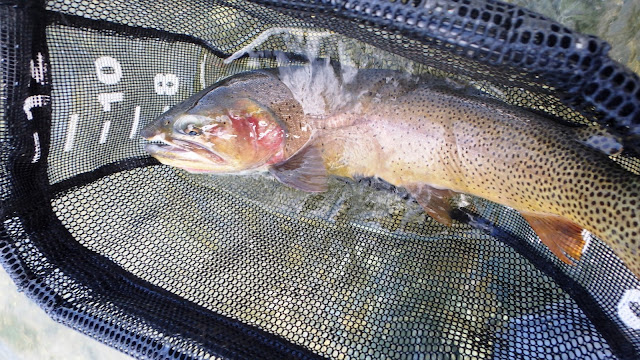It's that time of year. A section of Yellowstone River in Yellowstone National Park, below Yellowstone Lake to above Falls has been opened for fishing on July 15th. I've been trying to make it there in between my guide schedules to meet the Native and feel & learn the history & legacy. This section has been one of reasons and destinations that my YNP Dawn Treader series was born. In addition, from this year, I have a lovely companion who goes anywhere with me, hence it's become "plural" from now on😊.
However, just like anything else in life, sometimes things wouldn't turn out as we plan or expect😐. On July 17th, we fished a couple of promising spots/sections and encountered short yet very doable pods of hatches and rises but it wasn't our day😒😕.
Not much to report except the prolific insect hatches, which is the most known and discussed subject of this section. There were several different species of insects flying and number of each species was tremendous😲.
Here's the list of observation.
Mayfly:
Green Drake (picture, that I believe)
Gray Drake
Western Red Quill
PMD
Caddis:
Hydropsyche (tan & gray patterns)
Stoneflies:
Giant Salmonfly
Golden Stone
It's amazing to see so many "big bugs" were flying and on the water = Green Drake and two species of stoneflies.
Then I had to feel and realize couple of my gears have been worn out pretty much at the same time😞. Long story short for each: wader, 6-wt rod, and reel.............. These notches on my reel are proud scars of endurance and hauling in so many big fish for me (up to 34-inch 25-pound King Salmon), but it will damage the line.............. Time to get retired and hung on the wall😌
We reviewed and analyzed this unproductive day of fishing (it wasn't pleasant) and discussed how we could improve. Three days later, July 20th, we hit the road again. This time, my brain was composed and I was able to "think like fish" and we had strategies. We did "prospect" (meaning to search the likely spots with nymphs and streamers) but our focus was hatch and rise. We waited patiently. Cutthroat in this section & at this time year are totally different from other trout in further down the river (Cutt included). We have only a very short window to get to them (whatever fishing method we employ) and their behavioral patterns (or strategies for our perspective) may change every year. This time we did it right. We started to see insect hatches so I rigged dry-flies on Renee's rod. The moment we were ready, so were they. They were rising right in front of us😲. Renee made the first cast and a huge head came up on her #16 caddis dry-fly.
She worked on the fish very carefully and I netted for her😉
Photo session was equally a careful operation.
It was 22-inch long, her record trout 😙😎🎉🎊😂
Insects hatches were tremendous again. Here I seined Green Drake spinner (right) and Red Quill (might be Gray Drake) at the same time.
By the way, I caught two 14-inch Cutt on a caddis dry-fly too😅
Then we spotted some more rises of BIIIIIIIIIIIG ones but couldn't really get to. Then weather turned out be frequent lightning plus occasional pouring rain - I wouldn't expect too many hatches & rises - so we headed out.
I believe the high water of this season is affecting Cutt's activities and contributing conundrums on our fishing (well, so was the last year = historically one of the lowest flow).
I have observed and learned from the River then gained from the unpleasant day - another classroom experience of fly-fishing.
As majority of you already know, this Lake-River section, Yellowstone Cutthroat, and, I wouldn't mind mentioning, Lake Trout have been hot topics for the past 20 years. Oftentimes it can be politic. Regardless of what's said and done by or among human being, Cutthroat still exist and fishing this section is something very special. I'd like to say, come & fish (while you can - by that I "might" imply one's physical limitations or perhaps some political moves) and meet the true native of North American trout.







No comments:
Post a Comment